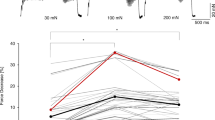Summary
Experiments were carried out on frogs and rats, and a study was made of the effect of the pessimum condition on the recovery of contractility of a fatigued muscle subjected to direct and indirect stimulation. When the pessimum condition was induced by high frequency stimuli, muscular excitability increased, and with low frequency stimulation it fell. When in the pessimum condition muscular excitability is reduced, the contractility of a fatigued muscle in response to a direct stimulus is accelerated; however, a pessimum state in which excitability is augmented is followed by a delayed restoration of contractility elicited by a direct stimulus, though there is no delay when the stimulus is indirect.
Similar content being viewed by others
Literature Cited
I. A. Arshavskii and M. N. Kondrashova, Fiziol. zh. SSSR, No. 2, p. 194 (1959).
I. S. Beritashvili, The General Physiology of the Muscular and Nervous System [in Russian] Moscow, Leningrad Vol. 1 (1947).
N. E. Wedensky, Complete Collected Works. [in Russian] Leningrad, Vol. 2 (1951).
D. S. Vorontsov, Fiziol. zh. SSSR, No. 3-4, p. 317 (1937); No. 3, p. 502 (1938).
A. G. Ginetsinskii and N. I. Michelson, Fiziol. zh. SSSR, No. 5, p. 968 (1935).
P. G. Kostyuk, In book: Reports of the 20th International Conference of Physiologists in Brussels. [in Russian] Moscow, p. 272 (1956); Biofizika, No. 3, p. 274 (1958); No. 2, p. 134 (1959).
L. V. Latmanizova, The Laws of Wedensky in the Electrical Activity of Excitable Units. [in Russian] Leningrad (1949).
A. N. Magnitskii, Recent Advances in Biology, Vol. 26 No. 3 (6), p. 875 (1948); Zh. vyssh. nervn deyat., No. 1, p. 128 (1951).
L. G. Trofimov, The Mechanism of Pessimal Inhibition. Dissertation for Doctorate. Moscow (1941).
N. M. Shamarina, Abstracts of Reports of the Third Conference on Problems on Electrophysiology. Kiev, p. 400 (1960).
A. I. Shapovalov, Fiziol. zh. SSSR, No. 9, p. 1112 (1960).
K. Krnjevic and R. Miledi, Nature, Vol. 180, p. 814 (1957).
A. W. Liley, J. Physiol. (Lond.), Vol 133, p. 571 (1956).
Author information
Authors and Affiliations
Additional information
Translated from Byulleten', Éksperimental'noi Biologii i Meditsiny, Vol. 53, No. 5, pp. 17–22, May, 1962
Rights and permissions
About this article
Cite this article
Tanin, S.A. The influence of the pessimum on the recovery of contractility of skeletal muscle. Bull Exp Biol Med 53, 498–502 (1963). https://doi.org/10.1007/BF00786730
Received:
Issue Date:
DOI: https://doi.org/10.1007/BF00786730




